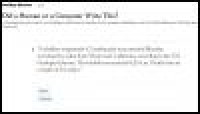Automated hacks
Computers have begun writing reports and data analysis for news organisations.
What next, asks SEVANTI NINAN. Pix: the NYT quiz

TALKING MEDIA
Sevanti Ninan
There is a whole new field of media practice emerging which has not found any reflection yet in the media debates here. But there has been a good deal of writing on it in the international press in the first quarter of 2015, and media conferences abroad are already debating the trend.
This is to do with further automation in the newsroom—not the kind which speeds up publishing processes, but the kind which does what journalists used to do, only maybe in nano seconds rather than in a few hours. If search robots can gather information forwhat you write, they can also go a step further and do the writing. Hows that for giving already sleepless journalists’ unions something to worry about?
Much of the coverage has been about the Associated Press which began using robots last June and published a story this January which caught attention. Therewas no byline. But it said at the end of the report, that it had been generated by Automated Insights (AI) using data from such and such investment research company. There are estimated to be some ten companies worldwide like AI, some are already unleashing their journalism, others are still evolving or testing their robots.
AP is partnering with this company for robot technology that ingests data such as company quarterly earnings, and then processes it to produce the text of a data story. How a wire service in particular benefits is that this scales up significantly the number of companies AP can analyse and put out stories on. Or weather, or sports or other data stories. Software is after all much faster than a human. The number of wire service releases goes from hundreds to thousands. It helps that robots don’t get bored with what they are doing.
But it isn’t only about scale. Computers can be inventive too. Earlier this month (March 8) the New York Times Sunday Review ran a lovely quiz which asked, “Did a computer or human write this?” At the end of each excerpt you had to tick the computer, or human options. There was even a stanza of poetry among the items in the quiz. “In truth, I’d love to build some verse for you/To churn such verse a billion times a day/So type a new concept for me to chew/I keep all waiting long, I hope you stay.” Computer or human? Ha!
If you guessed right you will know where this story is going. The bots can write poetry, data stories, novels. One florid para in the quiz about a woman who couldn’t sleep is fromThe Russian novel True Love, which was written by a computer in St. Petersburg in 72 hours.
Will newsroom hacks now have to walk around wearing tee shirts which say, ‘Hey, I am smarter than a computer programme!’ ?
This is likely to be the year when there will be more automated journalism produced and more discussion on this trend. At the WAN-Ifra conference of the World Association of Newspapers this March a lot of issues were put on the table. And the process by which a robot writes a story was explained: it ingests data, analyses, categorises and contextualises data, identifies and prioirtises insights and trends, arranges newsworthy elements and structures, and then publishes!
The positives were that it freed up newsroom staff to do other things, and gave the company more reports to sell to clients. The negative will come when companies wonder if they can reduce human staff accordingly.
Apart from Automated Insights there is a company Narrative Science which has developed a writing software called Quill. The brains for these automated writing programmes come from computer science professors at universities. One of them who is the chief scientist at Quill told the MIT Technology Review, “We know how to introduce an idea, how not to repeat ourselves, how to get shorter.”
But who will fact check and get quotes? Presumably humans. At least for now.Robots are likely to make fewer mistakes than human reporters but AP editors have also voiced the concern that you have to do constant quality checks because if a mistake does happen it gets multiplied in hundreds or thousands of stories or reports in no time.
Quill even angles stories to suit the market it is for. This the the example Narrative Science gave the MIT Review: it can accentuate the positive in marketing copy, or go for exhaustive detail in a regulatory filing.
Neither is a media function. But what if it angles stories differently for different news consumers, what does that do to straight reporting?
The point ofcourse is that as it evolves, the writing skill of these technologies will not be meant only for newrooms, but also for data processing companies, even intelligence agencies. The Central Intelligence Agency has made an investment in Narrative Science so that it can develop functions of use to them.
Even as it leads this new newsroom trend, AP has a standards editor, Tom Kent, who has worked out the ethical issues which will arise. He shared them at the Global Editors Network (GEN) summit last year.Does the robot vary its style or does it use the same phrasing for every story?
Is it picking data from accurate sources? Does the publishing company have rights to that data? Or photographs that it uses? And finally, will you disclose to your reader that he is reading a story produced by a computer?!
Purely from an India publishers viewpoint though this new workforce would have one overriding plus point: it would not be asking for wage board pay scales!
(Another version of this column appeared in Mint on March 19, 2015.)
Subscribe To The Newsletter






